Bulk Viscous Fluid in Symmetric Teleparallel Cosmology: Theory versus Experiment
Abstract
1. Introduction
2. Fundamental Formulations in Gravity
3. The Cosmological Model
4. Observational Constraints
4.1. Hubble Datasets
4.2. BAO Datasets
4.3. Pantheon Datasets
4.4. Cosmological Parameters
5. Energy Conditions
- Null energy condition (NEC):;
- Weak energy condition (WEC): and ;
- Dominant energy condition (DEC):;
- Strong energy condition (SEC):.
6. Statefinder Analysis
7. Discussions and Conclusions
Author Contributions
Funding
Institutional Review Board Statement
Informed Consent Statement
Data Availability Statement
Acknowledgments
Conflicts of Interest
References
- Riess, A.G.; Filippenko, A.V.; Challis, P.; Clocchiatti, A.; Diercks, A.; Garnavich, P.M.; Gilliland, R.L.; Hogan, C.J.; Jha, S.; Kirshner, R.P.; et al. Observational Evidence from Supernovae for an Accelerating Universe and a Cosmological Constant. Astron. J. 1998, 116, 1009. [Google Scholar] [CrossRef]
- Perlmutter, S.; Aldering, G.; Goldhaber, G.; Knop, R.A.; Nugent, P.; Castro, P.G.; Deustua, S.; Fabbro, S.; Goobar, A.; Groom, D.E.; et al. Measurements of Ω and Λ from 42 High-Redshift Supernovae. Astrophys. J. 1999, 517, 565. [Google Scholar] [CrossRef]
- Koivisto, T.; Mota, D.F. Dark energy anisotropic stress and large scale structure formation. Phys. Rev. D 2006, 73, 083502. [Google Scholar] [CrossRef]
- Daniel, S.F. Large scale structure as a probe of gravitational slip. Phys. Rev. D 2008, 77, 103513. [Google Scholar] [CrossRef]
- Eisenstein, D.J.; Zehavi, I.; Hogg, D.W.; Scoccimarro, R.; Blanton, M.R.; Nichol, R.C.; Scranton, R.; Seo, H.-J.; Tegmark, M.; Zheng, Z.; et al. Detection of the Baryon Acoustic Peak in the Large-Scale Correlation Function of SDSS Luminous Red Galaxies. Astrophys. J. 2005, 633, 560. [Google Scholar] [CrossRef]
- Percival, W.J.; Reid, B.A.; Eisenstein, D.J.; Bahcall, N.A.; Budavari, T.; Frieman, J.A.; Fukugita, M.; Gunn, J.E.; Ivezic, Z.; Knapp, G.R.; et al. Baryon acoustic oscillations in the Sloan Digital Sky Survey Data Release 7 galaxy sample. Mon. Not. R. Astron. Soc. 2010, 401, 2148–2168. [Google Scholar] [CrossRef]
- Caldwell, R.R.; Doran, M. Cosmic microwave background and supernova constraints on quintessence: Concordance regions and target models. Phys. Rev. D 2004, 69, 103517. [Google Scholar] [CrossRef]
- Huang, Z.Y.; Wang, B.; Abdalla, E.; Suet, R.K. Holographic explanation of wide-angle power correlation suppression in the cosmic microwave background radiation. J. Cosm. Astrop. Phys. 2006, 0605, 013. [Google Scholar] [CrossRef]
- Dalal, N.; Abazajian, K.; Jenkins, E.; Manoharet, A.V. Testing the Cosmic Coincidence Problem and the Nature of Dark Energy. Phys. Rev. Lett. 2001, 87, 141302. [Google Scholar] [CrossRef]
- Weinberg, S. The cosmological constant problem. Rev. Mod. Phys. 1989, 61, 1. [Google Scholar] [CrossRef]
- Bento, M.C.; Bertolami, O.; Sen, A.A. Generalized Chaplygin gas, accelerated expansion, and dark-energy-matter unification. Phys. Rev. D 2002, 66, 043507. [Google Scholar] [CrossRef]
- Kamenshchik, A.Y.; Moschella, U.; Pasquier, V. An alternative to quintessence. Phys. Lett. B 2001, 511, 265. [Google Scholar] [CrossRef]
- Chiba, T.; Okabe, T.; Yamaguchi, M. Kinetically driven quintessence. Phys. Rev. D 2000, 62, 023511. [Google Scholar] [CrossRef]
- Armendariz-Picon, C.; Mukhanov, V.; Steinhardt, P.J. Dynamical Solution to the Problem of a Small Cosmological Constant and Late-Time Cosmic Acceleration. Phys. Rev. Lett. 2000, 85, 4438. [Google Scholar] [CrossRef]
- Carroll, S.M. Quintessence and the Rest of the World: Suppressing Long-Range Interactions. Phys. Rev. Lett. 1998, 81, 3067. [Google Scholar] [CrossRef]
- Fujii, Y. Origin of the gravitational constant and particle masses in a scale-invariant scalar-tensor theory. Phys. Rev. D 1982, 26, 2580. [Google Scholar] [CrossRef]
- Xu, L.; Wang, Y.; Tong, M.; Noh, H. CMB temperature and matter power spectrum in a decay vacuum dark energy model. Phys. Rev. D 2011, 84, 123004. [Google Scholar] [CrossRef]
- Tong, M.; Noh, H. Observational constraints on decaying vacuum dark energy model. Eur. Phys. J. C 2011, 71, 1586. [Google Scholar] [CrossRef]
- Freese, K.; Adams, F.C.; Frieman, J.A.; Mottola, E. Cosmology with decaying vacuum energy. Nucl. Phys. B 1987, 287, 797. [Google Scholar] [CrossRef]
- Abdel-Rahman, A.-M.M. Nonsingular decaying-vacuum cosmology and baryonic matter. Phys. Rev. D 1992, 45, 3497. [Google Scholar] [CrossRef]
- Appleby, S.; Battye, R. Do consistent F(R) models mimic General Relativity plus Λ. Phys. Lett. B 2007, 654, 7. [Google Scholar] [CrossRef]
- Amendola, L.; Gannouji, R.; Polarski, D.; Tsujikawa, S. Conditions for the cosmological viability of f(R) dark energy models. Phys. Rev. D 2007, 75, 083504. [Google Scholar] [CrossRef]
- Saffari, R.; Rahvar, S. f(R) gravity: From the Pioneer anomaly to cosmic acceleration. Phys. Rev. D 2008, 77, 104028. [Google Scholar] [CrossRef]
- Cognola, G.; Elizalde, E.; Nojiri, S.; Odintsov, S.D.; Zerbini, S. Dark energy in modified Gauss-Bonnet gravity: Late-time acceleration and the hierarchy problem. Phys. Rev. D 2006, 73, 084007. [Google Scholar] [CrossRef]
- Li, B.; Barrow, J.D.; Mota, D.F. Cosmology of modified Gauss-Bonnet gravity. Phys. Rev. D 2007, 76, 044027. [Google Scholar] [CrossRef]
- Moraes, P.H.R.S.; Santos, J.R.L. A complete cosmological scenario from f(R,Tϕ) gravity theory. Eur. Phys. J. C 2016, 76, 60. [Google Scholar]
- Ren, X.; Wong, T.H.T.; Cai, Y.F.; Saridakis, E.N. Data-driven Reconstruction of the Late-time Cosmic Acceleration with f(T) Gravity. Phys. Dark Univ. 2021, 32, 100812. [Google Scholar] [CrossRef]
- Nashed, G.L.; Capozziello, S. Charged Anti-de Sitter BTZ black holes in Maxwell-f(T) gravity. Gen. Rel. Grav. 2015, 47, 75. [Google Scholar] [CrossRef]
- Setare, M.R.; Mohammadipour, N. Can f(T) gravity theories mimic ΛCDM cosmic history. J. Cosm. Astrop. Phys. 2013, 01, 015. [Google Scholar] [CrossRef]
- Bahamonde, S.; Dialektopoulos, K.; Escamilla-Rivera, C.; Farrugia, G.; Gakis, V.; Hendry, M.; Hohmann, M.; Said, J.; Mifsud, J.; Valentino, E.D. Teleparallel Gravity: From Theory to Cosmology. arXiv 2021, arXiv:2106.13793. [Google Scholar] [CrossRef]
- Jiménez, J.B.; Heisenberg, L.; Koivisto, T. Coincident general relativity. Phys. Rev. D 2018, 98, 044048. [Google Scholar] [CrossRef]
- Hehl, F.W.; McCrea, J.D.; Mielke, E.W.; Neéman, Y. Metric-affine gauge theory of gravity: Field equations, Noether identities, world spinors, and breaking of dilation invariance. Phys. Rep. 1995, 258, 1–171. [Google Scholar] [CrossRef]
- Hehl, F.W.; Neéman, Y.; Nitsch, J.; Heyde, P.V.D. Short-range confining component in a quadratic poincare gauge theory of gravitation. Phys. Lett. B 1978, 78, 102–106. [Google Scholar] [CrossRef]
- Hehl, F.W.; Obukhov, Y.N. How does the electromagnetic field couple to gravity, in particular to metric, nonmetricity, torsion, and curvature ? arXiv 2000, arXiv:0001010. [Google Scholar]
- Ne’eman, Y.; Hehl, F.W. Matter Particled—Patterns, Structure and Dynamics. Class. Quant. Grav. 1997, 14, 251–260. [Google Scholar]
- Nester, J.M.; Yo, H.-J. Symmetric teleparallel general relativity. Chin. J. Phys. 1999, 37, 113. [Google Scholar]
- Boulanger, N.; Kirsch, I. Higgs mechanism for gravity. II. Higher spin connections Phys. Rev. D 2006, 73, 124023. [Google Scholar]
- Baekler, P.; Boulanger, N.; Hehl, F.W. Linear connections with a propagating spin-3 field in gravity. Phys. Rev. D 2006, 74, 125009. [Google Scholar] [CrossRef]
- Weyl, H. Gravitation and electricity. Sitzungsber. Preuss. Akad. Wiss. 1918, 465, 1. [Google Scholar] [CrossRef]
- Dialektopoulos, K.F.; Koivisto, T.S.; Capozziello, S. Noether symmetries in symmetric teleparallel cosmology. Eur. Phys. J. C 2019, 79, 606. [Google Scholar] [CrossRef]
- Frusciante, N. Signatures of f(Q) gravity in cosmology. Phys. Rev. D 2021, 103, 044021. [Google Scholar] [CrossRef]
- Barros, B.J.; Barreiro, T.; Koivisto, T.; Nunes, N.J. Testing F(Q) gravity with redshift space distortions. Phys. Dark Univ. 2020, 30, 100616. [Google Scholar] [CrossRef]
- Ferreira, J.; Barreiro, T.; Mimoso, J.; Nunes, N.J. Forecasting F(Q) cosmology with ΛCDM background using standard sirens. Phys. Rev. D 2022, 105, 123531. [Google Scholar] [CrossRef]
- Albuquerque, I.S.; Frusciante, N. A designer approach to f(Q) gravity and cosmological implications. Phys. Dark Univ. 2022, 35, 100980. [Google Scholar] [CrossRef]
- Capozziello, S.; D’Agostino, R. Model-independent reconstruction of f(Q) non-metric gravity. Phys. Lett. B 2022, 832, 137229. [Google Scholar] [CrossRef]
- Atayde, L.; Frusciante, N. Can f(Q) gravity challenge ΛCDM . Phys. Rev. D 2022, 104, 064052. [Google Scholar] [CrossRef]
- Ayuso, I.; Lazkoz, R.; Salzano, V. Observational constraints on cosmological solutions of f(Q) theories. Phys. Rev. D 2021, 103, 063505. [Google Scholar] [CrossRef]
- Khyllep, W. Cosmology in f(Q) gravity: A unified dynamical system analysis at background and perturbation levels. arXiv 2022, arXiv:2207.02610. [Google Scholar]
- Sahlu, S.; Tsegaye, E. Linear Cosmological perturbations in F(Q) Gravity. arXiv 2022, arXiv:2206.02517. [Google Scholar]
- Jiménez, J.B.; Heisenberg, L.; Koivisto, T.; Pekar, S. Cosmology in f(Q) geometry. Phys. Rev. D 2020, 101, 103507. [Google Scholar] [CrossRef]
- Khyllep, W.; Paliathanasis, A.; Dutta, J. Cosmological solutions and growth index of matter perturbations in f(Q) gravity. Phys. Rev. D 2021, 103, 103521. [Google Scholar] [CrossRef]
- Mandal, S.; Wang, D.; Sahoo, P.K. Cosmography in f(Q) gravity. Phys. Rev. D 2020, 102, 124029. [Google Scholar] [CrossRef]
- Mandal, S.; Sahoo, P.K.; Santos, J.R.L. Energy conditions in f(Q) gravity. Phys. Rev. D 2020, 102, 024057. [Google Scholar] [CrossRef]
- Wilson, J.R.; Mathews, G.J.; Fuller, G.M. Bulk viscosity, decaying dark matter, and the cosmic acceleration. Phys. Rev. D 2007, 75, 043521. [Google Scholar] [CrossRef]
- Okumura, H.; Yonezawa, F. New expression of the bulk viscosity. Phys. A 2003, 321, 207. [Google Scholar] [CrossRef]
- Bali, R.; Jain, D.R. Some expanding and shearing viscous fluid cosmological models in general relativity. Astrophys. Spa. Sci. 1988, 141, 207. [Google Scholar] [CrossRef]
- Bali, R.; Jain, D.R. A gravitationally non-degenerate cosmological model with expanding and shearing viscous fluid in general relativity. Astriphys. Spa. Sci. 1987, 139, 175. [Google Scholar] [CrossRef]
- Deng, Y.; Mannheim, P.D. Acceleration-free spherically symmetric inhomogeneous cosmological model with shear viscosity. Phys. Rev. D 1991, 44, 1722. [Google Scholar] [CrossRef]
- Huang, W.-H. Effects of the shear viscosity on the character of cosmological evolution. J. Math. Phys. 1990, 31, 659. [Google Scholar] [CrossRef]
- Samanta, G.C.; Myrzakulov, R.; Shah, P. Kaluza–Klein Bulk Viscous Fluid Cosmological Models and the Validity of the Second Law of Thermodynamics in f(R,T) Gravity. Zeits. Naturfor. 2017, 72, 365. [Google Scholar] [CrossRef]
- Satish, J.; Venkateswarlu, R. Bulk viscous fluid cosmological models in f(R, T) gravity. Chin. J. Phys. 2016, 54, 830. [Google Scholar]
- Beesham, A. Cosmological Models with a Variable Cosmological Term and Bulk Viscous Models. Phys. Rev. D 1993, 48, 3539. [Google Scholar] [CrossRef] [PubMed]
- Colistete, R., Jr.; Fabris, J.C.; Tossa, J.; Zimdahl, W. Bulk viscous cosmology. Phys. Rev. D 2007, 76, 103516. [Google Scholar] [CrossRef]
- Sadatian, S.D. Effects of viscous content on the modified cosmological F(T) model. EPL 2019, 126, 30004. [Google Scholar] [CrossRef]
- Brevik, I. Viscosity in Modified Gravity. Entropy 2012, 14, 2302–2310. [Google Scholar] [CrossRef]
- Singh, C.P.; Kumar, P. Friedmann model with viscous cosmology in modified f(R,T) gravity theory. Eur. Phys. J. C 2014, 74, 3070. [Google Scholar] [CrossRef]
- Srivastava, M.; Singh, C.P. New holographic dark energy model with constant bulk viscosity in modified f(R,T) gravity theory. Astrophys. Space Sci. 2018, 363, 117. [Google Scholar] [CrossRef]
- Paolis, F.D.; Jamil, M.; Qadir, A. Black holes in bulk viscous cosmology. Int. J. Theor. Phys. 2010, 49, 621–632. [Google Scholar] [CrossRef]
- Brevik, I.; Jamil, M. Black holes in the turbulence phase of viscous rip cosmology. Int. J. Geom. Meth. Mod. Phys. 2019, 16, 1950030. [Google Scholar] [CrossRef]
- Jimenez, R.; Loeb, A. Constraining cosmological parameters based on relative galaxy ages. ApJ 2002, 573, 37. [Google Scholar] [CrossRef]
- Sharov, G.S.; Bhattacharya, S.; Pan, S.; Nunes, R.C.; Chakraborty, S. A new interacting two-fluid model and its consequences. Mon. Not. R. Astron. Soc. 2017, 466, 3497. [Google Scholar] [CrossRef]
- Blake, C.; Kazin, E.A.; Beutler, F.; Davis, T.M.; Parkinson, D.; Brough, S.; Colless, M.; Contreras, C.; Couch, W.; Croom, S.; et al. The WiggleZ Dark Energy Survey: Mapping the distance-redshift relation with baryon acoustic oscillations. Mon. Not. R. Astron. Soc. 2011, 418, 1707. [Google Scholar] [CrossRef]
- Scolnic, D.M.; Jones, D.O.; Rest, A.; Pan, Y.C.; Chornock, R.; Foley, R.J.; Huber, M.E.; Kessler, R.; Narayan, G.; Riess, A.G.; et al. The complete light-curve sample of spectroscopically confirmed SNe Ia from Pan-STARRS1 and cosmological constraints from the combined pantheon sample. ApJ 2018, 859, 101. [Google Scholar] [CrossRef]
- Lazkoz, R.; Lobo, F.S.N.; Ortiz-Banos, M.; Salzano, V. Observational constraints of f(Q) gravity. Phys. Rev. D 2019, 100, 104027. [Google Scholar] [CrossRef]
- Beh, J.T.; Loo, T.H.; De, A. Geodesic Deviation Equation In f(Q) Gravity. arXiv 2021, arXiv:2107.04513. [Google Scholar] [CrossRef]
- Dimakis, N.; Paliathanasis, A.; Christodoulakis, T. Quantum Cosmology in f(Q) theory. arXiv 2021, arXiv:2108.01970. [Google Scholar] [CrossRef]
- Maluf, J.W. The teleparallel equivalent of general relativity. Ann. Phys. 2013, 525, 339. [Google Scholar] [CrossRef]
- Hohmann, M. General covariant symmetric teleparallel cosmology. Phys. Rev. D 2021, 104, 124077. [Google Scholar] [CrossRef]
- Vagnozzi, S.; Loeb, A.; Moresco, M. The cosmic chronometers take on spatial curvature and cosmic concordance. Astrophys. J. 2021, 908, 84. [Google Scholar]
- Gusakov, M.E. Bulk viscosity of superfluid neutron stars. Phys. Rev. D 2007, 76, 083001. [Google Scholar] [CrossRef]
- Gusakov, M.E.; Kantor, E.M. Bulk viscosity of superfluid hyperon stars. Phys. Rev. D 2008, 78, 083006. [Google Scholar] [CrossRef]
- Haensel, P.; Levenfish, K.P.; Yakovlev, D.G. Bulk viscosity in superfluid neutron star cores-III. Effects of hyperons. Astron. Astrophys. 2002, 381, 1080. [Google Scholar] [CrossRef]
- Ryden, B. Introduction to Cosmology; Addison Wesley: San Francisco, CA, USA, 2003. [Google Scholar]
- Odintsov, S.D.; Gomez, D.S.C.; Sharov, G.S. Testing the equation of state for viscous dark energy. Phys. Rev. D 2020, 101, 044010. [Google Scholar] [CrossRef]
- Fabris, J.C.; Goncalves, S.V.B.; Ribeiro, R. Bulk viscosity driving the acceleration of the Universe. Gen. Rel. Grav. 2006, 38, 495. [Google Scholar] [CrossRef]
- Meng, X.-H.; Dou, X. Friedmann cosmology with bulk viscosity: A concrete model for dark energy. Comm. Theor. Phys. 2009, 52, 377. [Google Scholar]
- Brevik, I.; Gorbunova, O. Dark energy and viscous cosmology. Gen. Rel. Grav. 2005, 37, 2039. [Google Scholar] [CrossRef]
- Gron, O. Viscous inflationary universe models. Astrophys. Space Sci. 1990, 173, 191–225. [Google Scholar] [CrossRef]
- Eckart, C. The thermodynamics of irreversible processes. III. Relativistic theory of the simple fluid Phys. Rev. 1940, 58, 919. [Google Scholar]
- Ren, J.; Meng, X.-H. Cosmological model with viscosity media (dark fluid) described by an effective equation of state. Phys. Lett. B 2006, 633, 1–8. [Google Scholar] [CrossRef]
- Harko, T.; Koivisto, T.S.; Lobo, F.S.N.; Olmo, G.J.; Rubiera-Garcia, D. Coupling matter in modified Q gravity. Phys. Rev. D 2018, 98, 084043. [Google Scholar] [CrossRef]
- Mackey, D.F.; Hogg, D.W.; Lang, D.; Goodman, J. emcee: The MCMC hammer. Publ. Astron. Soc. Pac. 2013, 125, 306. [Google Scholar] [CrossRef]
- Sharov, G.S.; Vasilie, V.O. How predictions of cosmological models depend on Hubble parameter data sets. Math. Model. Geom. 2018, 6, 1. [Google Scholar] [CrossRef]
- Beutler, F.; Blake, C.; Colless, M.; Jones, D.H.; Staveley-Smith, L.; Campbell, L.; Parker, Q.; Saunders, W.; Watson, F. The 6dF Galaxy Survey: Baryon acoustic oscillations and the local Hubble constant. Mon. Not. R. Astron. Soc. 2011, 416, 3017. [Google Scholar] [CrossRef]
- Jarosik, N.; Bennett, C.L.; Dunkley, J.; Gold, B.; Greason, M.R.; Halpern, M.; Hill, R.S.; Hinshaw, G.; Kogut, A.; Komatsu, E. SEVEN-YEAR WILKINSON MICROWAVE ANISOTROPY PROBE (WMAP) OBSERVATIONS: SKY MAPS, SYSTEMATIC ERRORS, AND BASIC RESULTS. Astrophys. J. Suppl. 2011, 192, 14. [Google Scholar] [CrossRef]
- Giostri, R.; Santos, M.V.d.; Waga, I.; Reis, R.R.R.; Calvao, M.O.; Lago, B.L. From cosmic deceleration to acceleration: New constraints from SN Ia and BAO/CMB. J. Cosm. Astropart. Phys. 2012, 03, 027. [Google Scholar] [CrossRef]
- Mukherjee, P.; Banerjee, N. Non-parametric reconstruction of the cosmological jerk parameter. Eur. Phys. J. C 2021, 81, 36. [Google Scholar] [CrossRef]
- Tripp, R. A two-parameter luminosity correction for Type IA supernovae. Astron. Astrophys. 1998, 331, 815. [Google Scholar]
- Kessler, R.; Scolnic, D. Correcting type Ia supernova distances for selection biases and contamination in photometrically identified samples. Astrophys. J. 2017, 836, 56. [Google Scholar] [CrossRef]
- Anagnostopoulos, F.K.; Basilakos, S.; Saridakis, E.N. Observational constraints on Myrzakulov gravity. Phys. Rev. D 2021, 103, 104013. [Google Scholar] [CrossRef]
- Vagnozzi, S.; Pacucci, F.; Loeb, A. Implications for the Hubble tension from the ages of the oldest astrophysical objects. JHEAp 2022, 36, 27–35. [Google Scholar] [CrossRef]
- Raychaudhuri, A. Relativistic cosmology I. Phys. Rev. 1955, 98, 1123. [Google Scholar] [CrossRef]
- Capozziello, S.; Lobo, F.S.N.; Mimoso, J.O. Energy conditions in modified gravity. Phys. Lett. B 2014, 730, 280–283. [Google Scholar] [CrossRef]
- Sahni, V.; Saini, T.D.; Starobinsky, A.A.; Alam, U. Statefinder-a new geometrical diagnostic of dark energy. JETP Lett. 2003, 77, 201. [Google Scholar] [CrossRef]
- CDMS II Collaboration. Science 2010, 327, 1619.
- Akerib, D.S.; Araujo, H.M.; Bai, X.; Bailey, A.J.; Balajthy, J.; Bedikian, S.; Bernard, E.; Bernstein, A.; Bolozdynya, A.; Bradley, A.; et al. First Results from the LUX Dark Matter Experiment at the Sanford Underground Research Facility. Phys. Rev. Lett. 2014, 112, 091303. [Google Scholar] [CrossRef] [PubMed]
- Essig, R.; Manalaysay, A.; Mardon, J.; Sorensen, P.; Volansky, T. First direct detection limits on sub-GeV dark matter from XENON10. Phys. Rev. Lett 2012, 109, 021301. [Google Scholar] [CrossRef] [PubMed]
- Bohmer, C.G.; Harko, T.; Lobo, F.S.N. Dark matter as a geometric effect in f(R) gravity. Astrop. Phys. 2008, 29, 386. [Google Scholar] [CrossRef]
- Mannheim, P.D.; O’Brien, J.G. Fitting galactic rotation curves with conformal gravity and a global quadratic potential. Phys. Rev. D 2012, 85, 124020. [Google Scholar] [CrossRef]
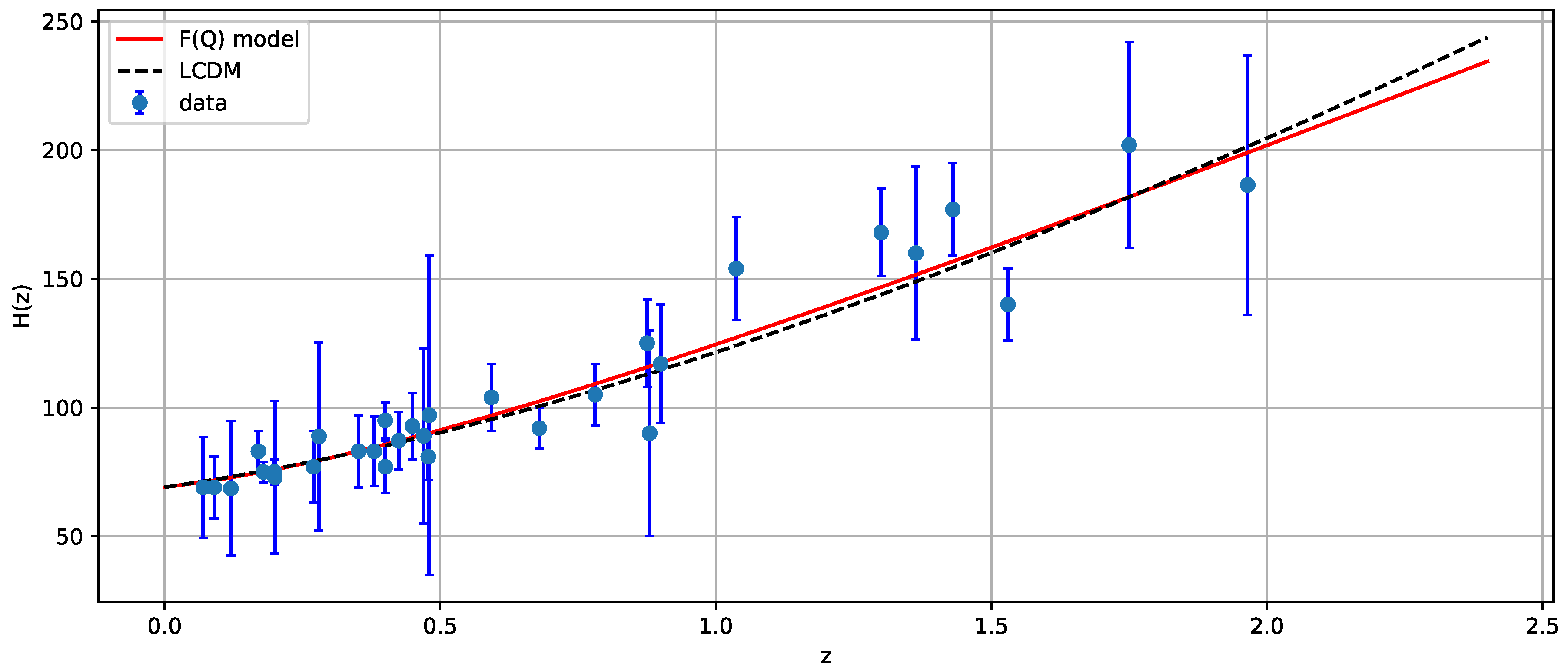

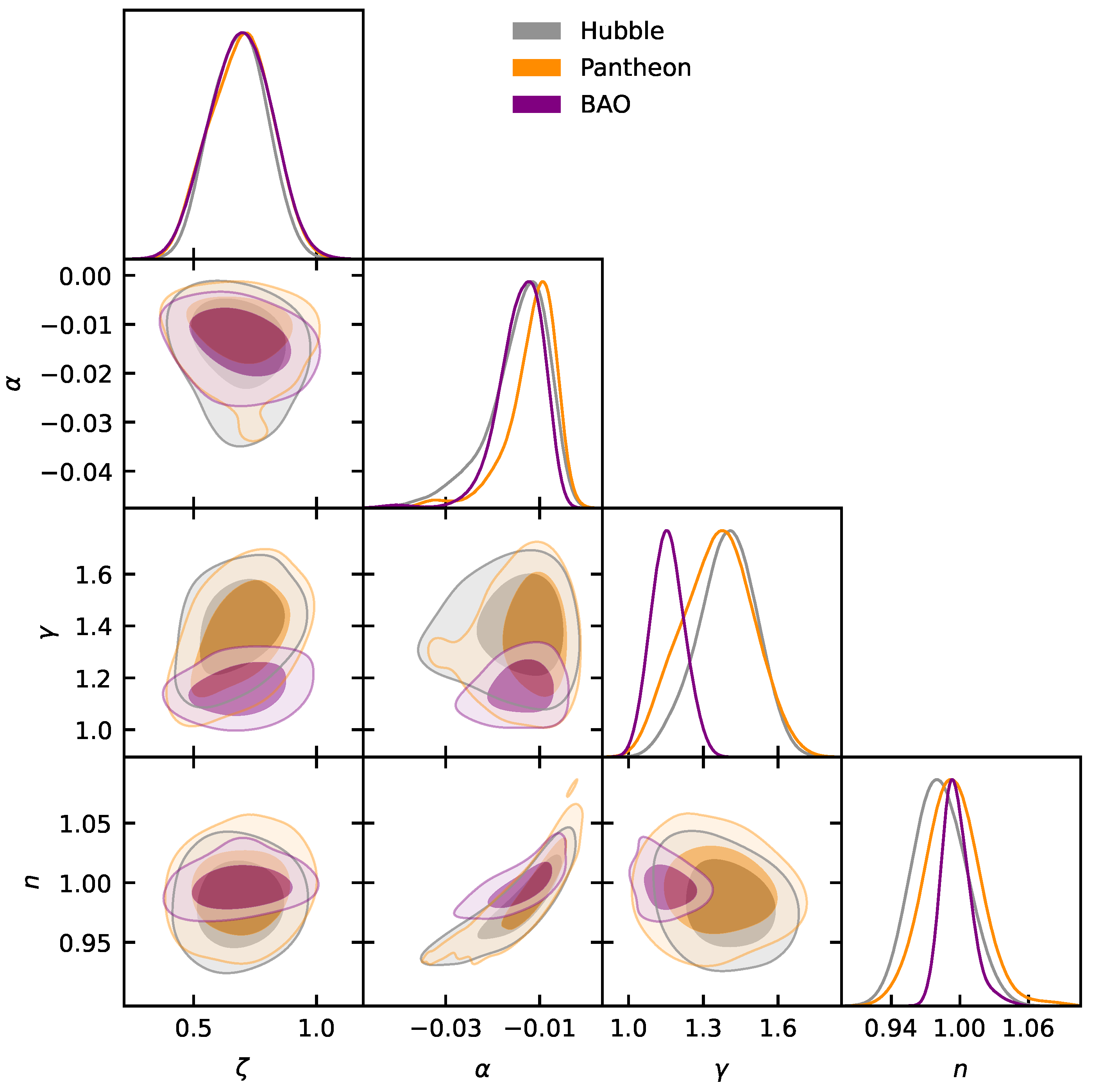

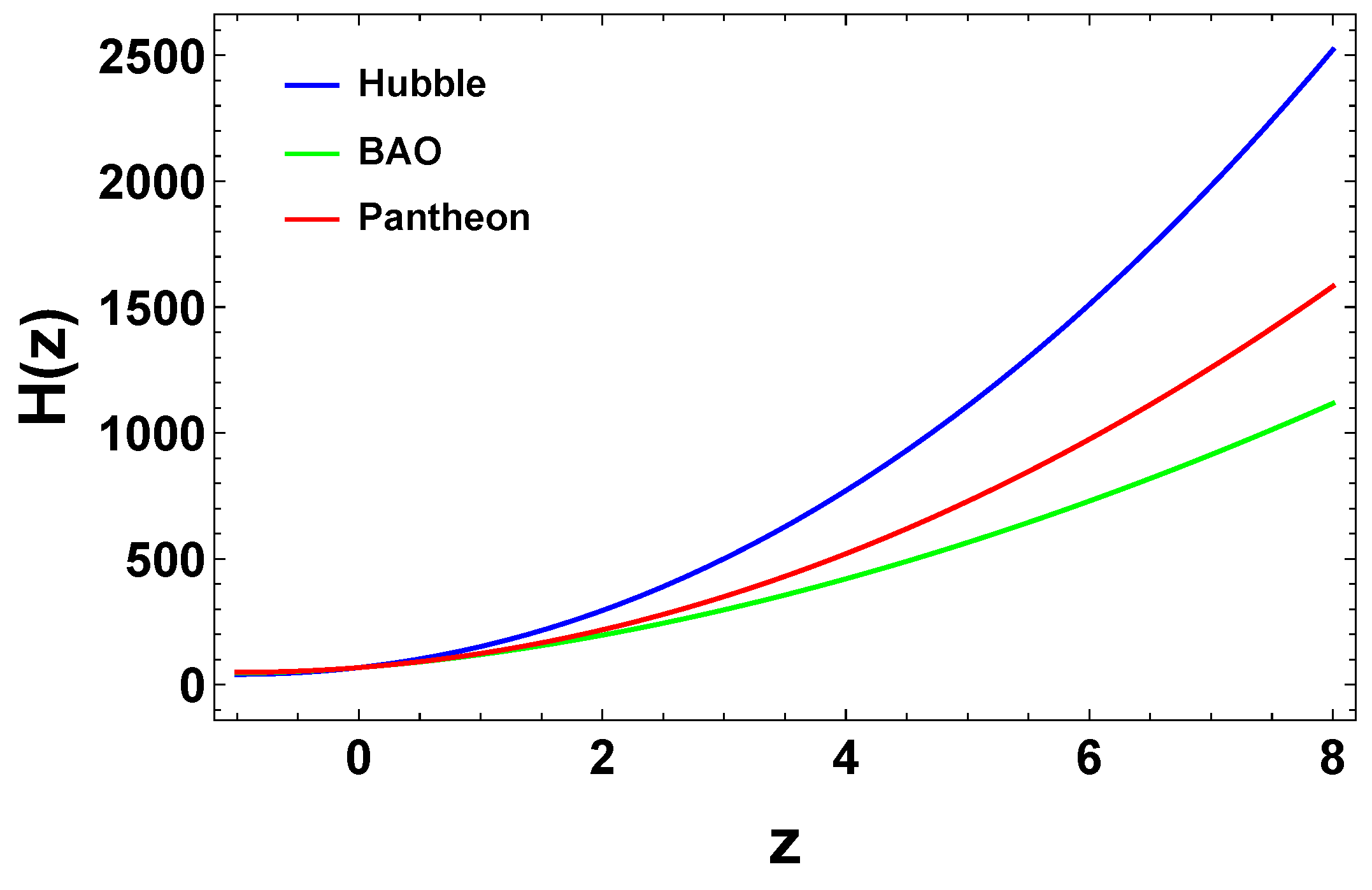

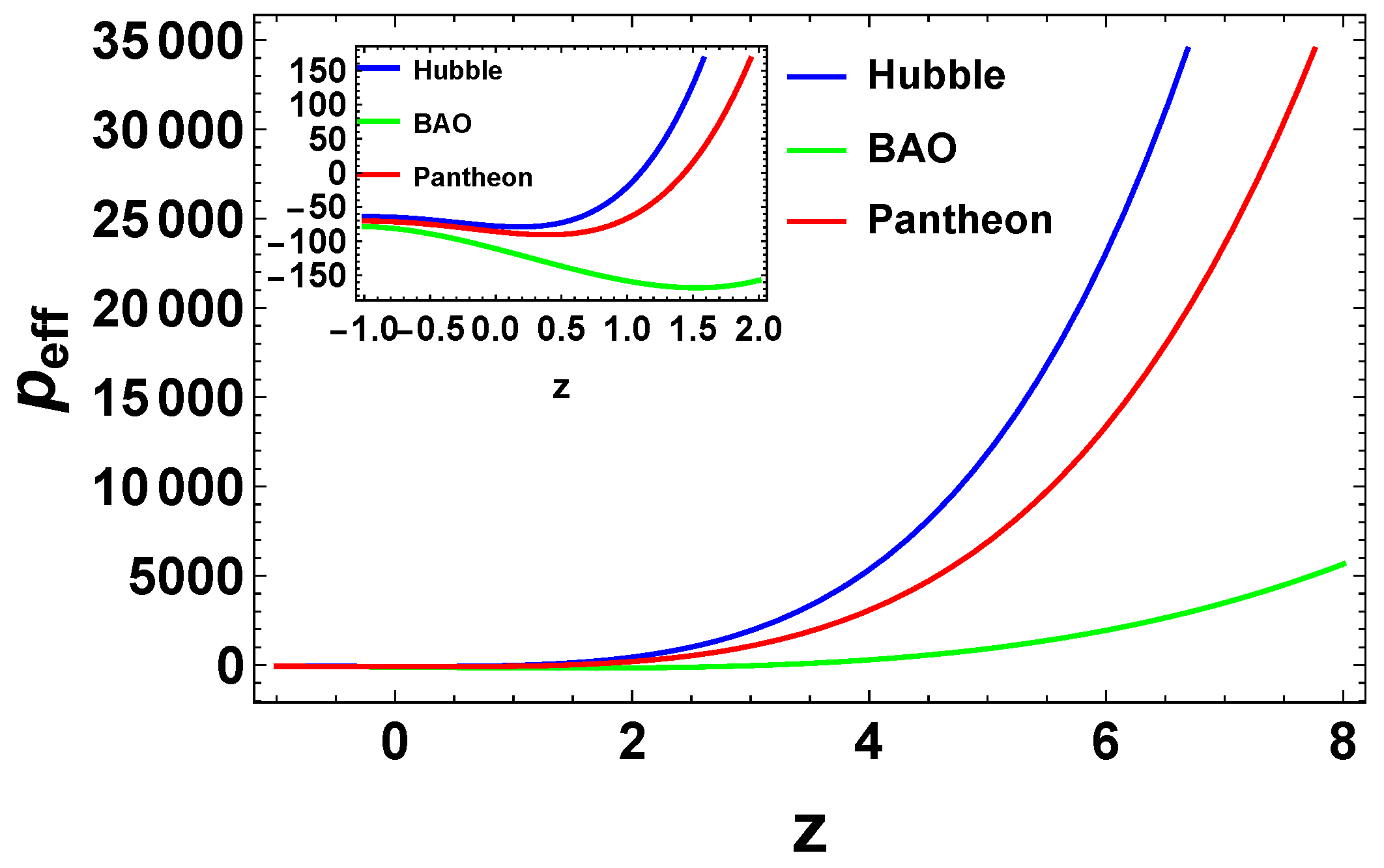
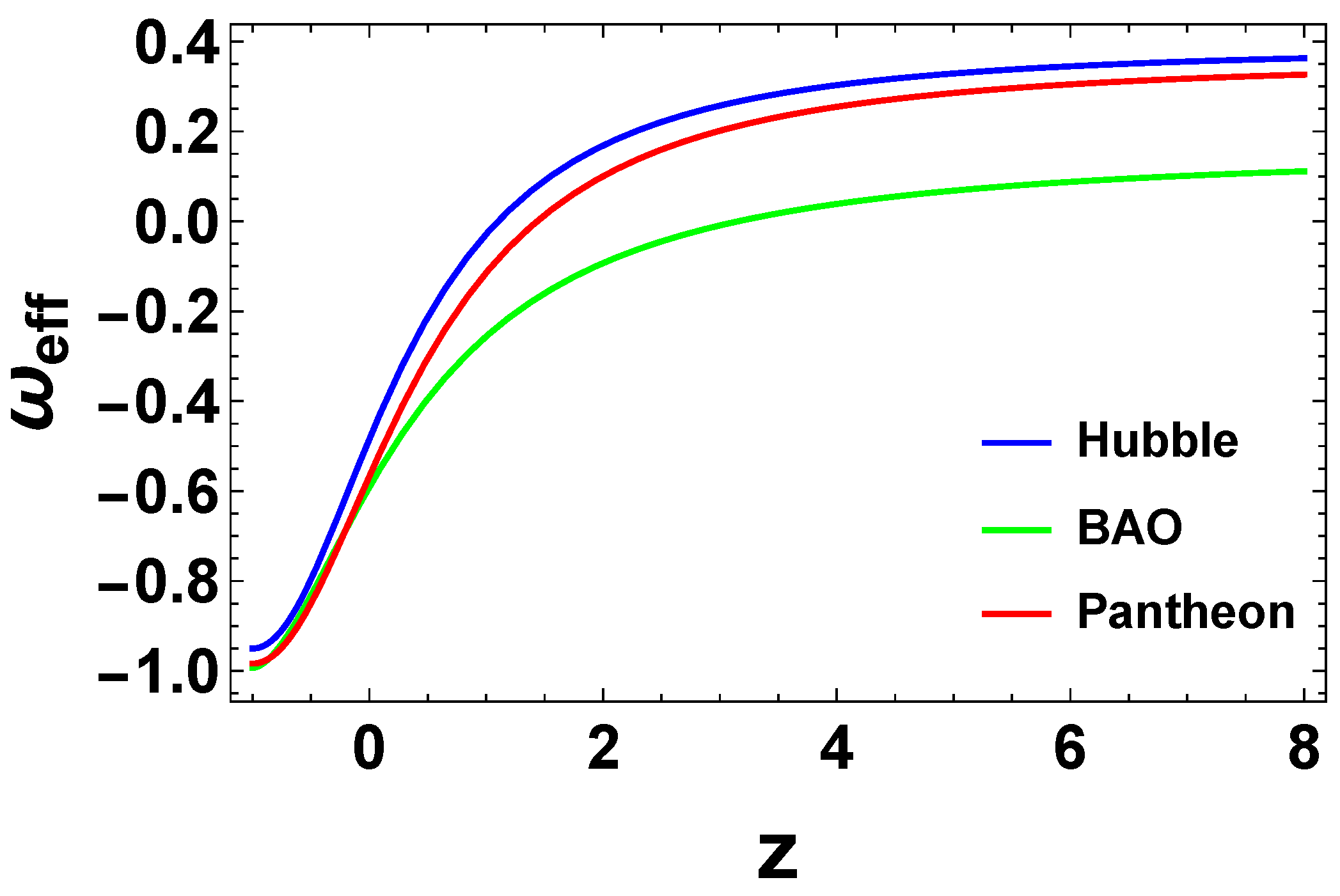


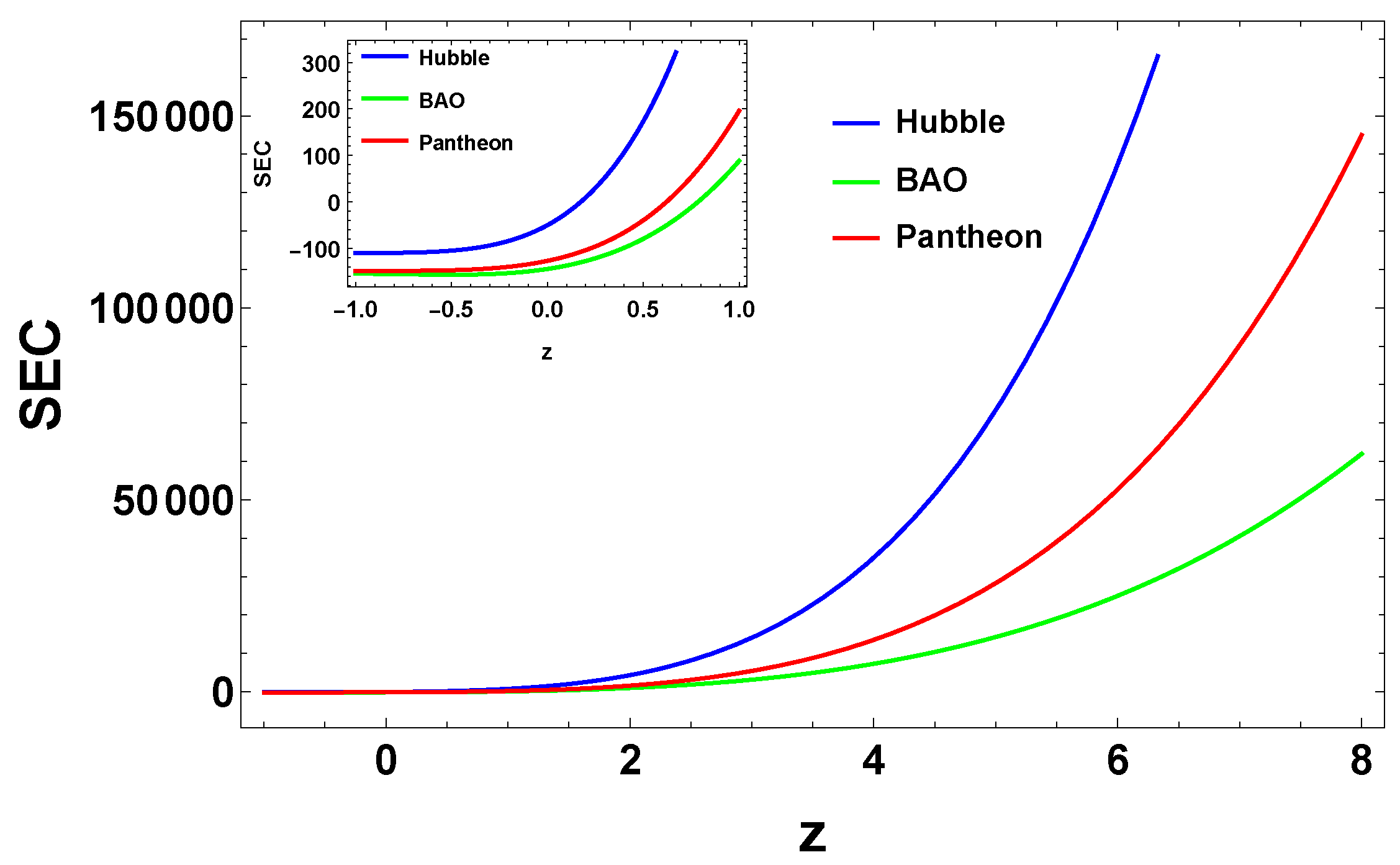
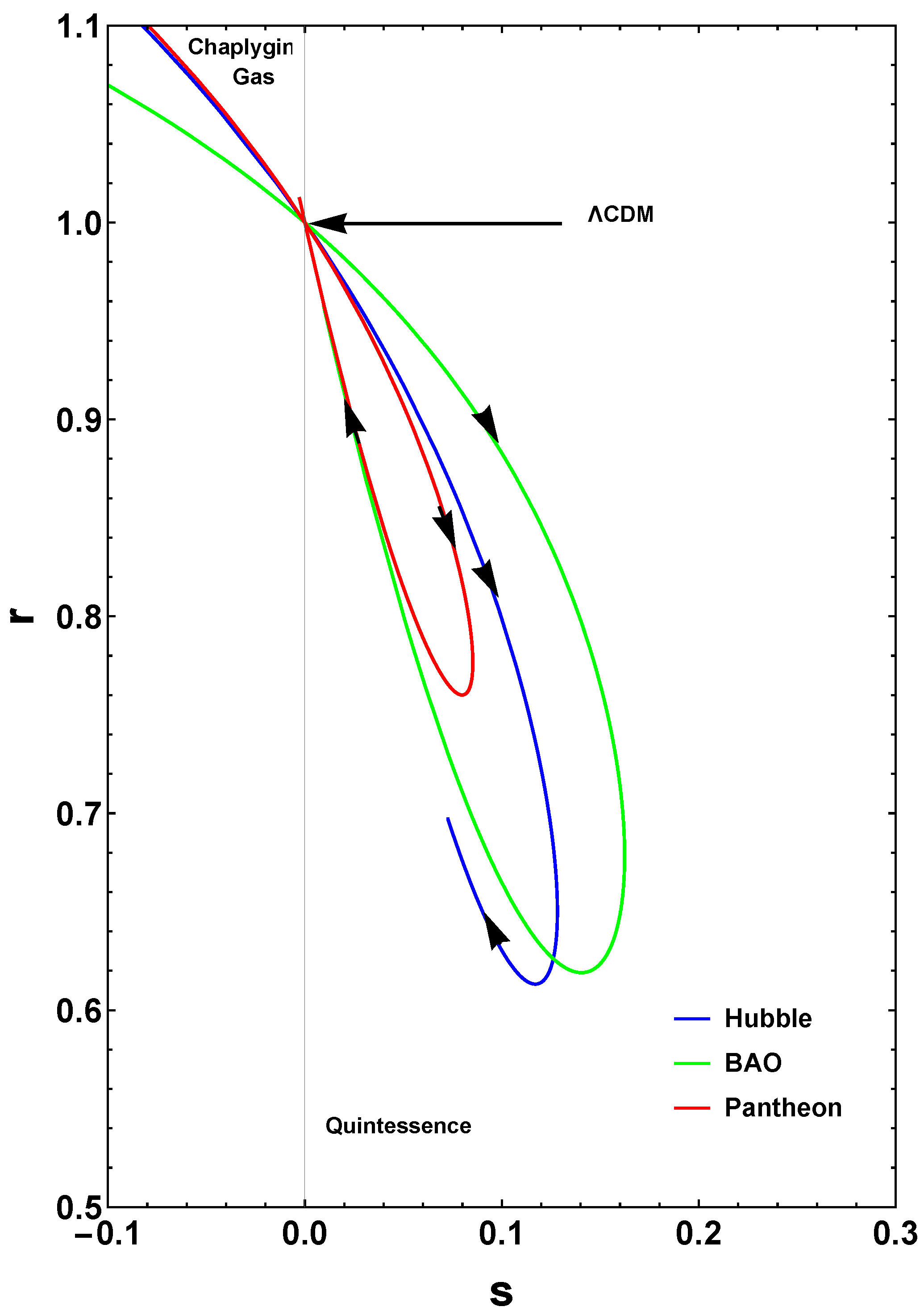
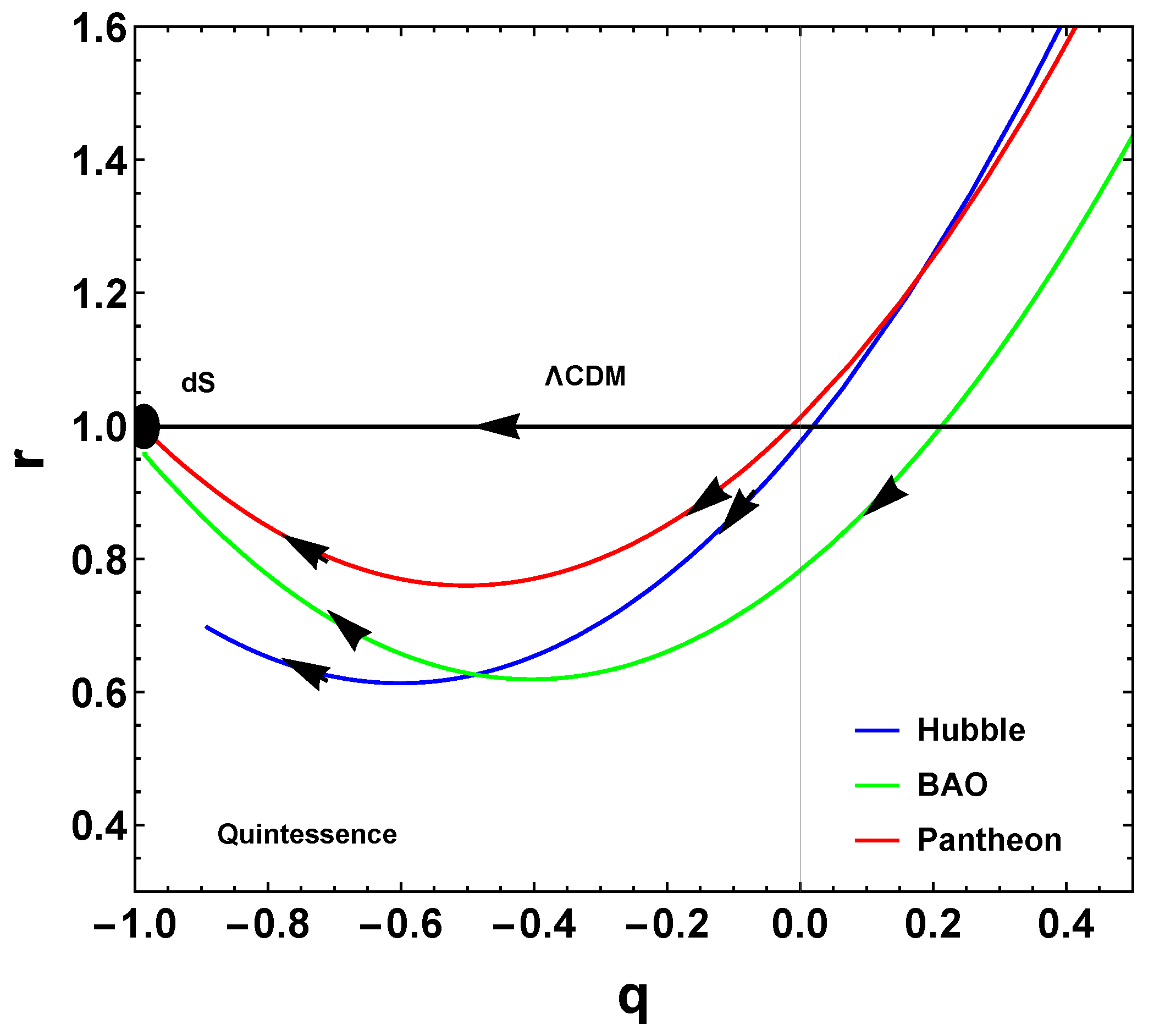
| Data | n | |||
|---|---|---|---|---|
| Hubble | ||||
| BAO | ||||
| Pantheon |
Disclaimer/Publisher’s Note: The statements, opinions and data contained in all publications are solely those of the individual author(s) and contributor(s) and not of MDPI and/or the editor(s). MDPI and/or the editor(s) disclaim responsibility for any injury to people or property resulting from any ideas, methods, instructions or products referred to in the content. |
© 2022 by the authors. Licensee MDPI, Basel, Switzerland. This article is an open access article distributed under the terms and conditions of the Creative Commons Attribution (CC BY) license (https://creativecommons.org/licenses/by/4.0/).
Share and Cite
Solanki, R.; Arora, S.; Sahoo, P.K.; Moraes, P.H.R.S. Bulk Viscous Fluid in Symmetric Teleparallel Cosmology: Theory versus Experiment. Universe 2023, 9, 12. https://doi.org/10.3390/universe9010012
Solanki R, Arora S, Sahoo PK, Moraes PHRS. Bulk Viscous Fluid in Symmetric Teleparallel Cosmology: Theory versus Experiment. Universe. 2023; 9(1):12. https://doi.org/10.3390/universe9010012
Chicago/Turabian StyleSolanki, Raja, Simran Arora, Pradyumn Kumar Sahoo, and Pedro H. R. S. Moraes. 2023. "Bulk Viscous Fluid in Symmetric Teleparallel Cosmology: Theory versus Experiment" Universe 9, no. 1: 12. https://doi.org/10.3390/universe9010012
APA StyleSolanki, R., Arora, S., Sahoo, P. K., & Moraes, P. H. R. S. (2023). Bulk Viscous Fluid in Symmetric Teleparallel Cosmology: Theory versus Experiment. Universe, 9(1), 12. https://doi.org/10.3390/universe9010012









